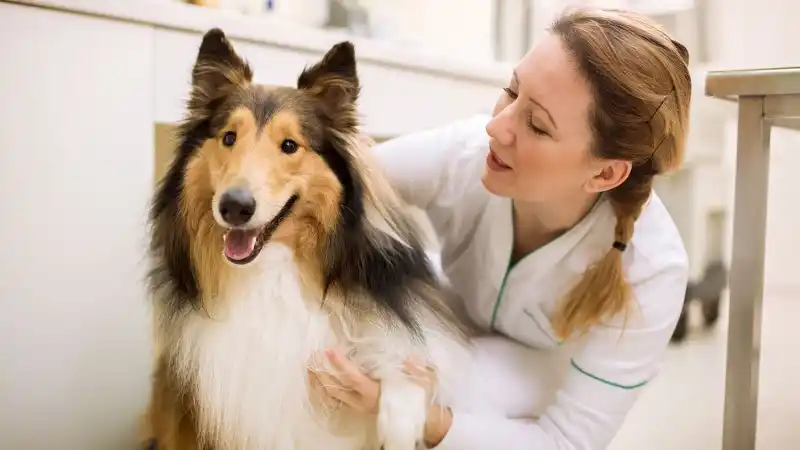Speaking Puppy: Communicating with Your New Dog
One of the most important & daunting tasks for a new dog owner is learning how to communicate with their pet. Here are tips on how to speak dog & read body language.

Becoming a pet owner for the first time is largely an educational process. First-time dog owners need to familiarize themselves with nutrition, socialization, and a whole lifetime’s worth of canine care topics. It’s a little like getting a new job _and_going back to school! Most daunting of all, building a strong, trusting relationship with a dog often means learning an entirely new language and communication style. Do you speak dog?
Speaking Dog
Use a calm, low voice: For both asserting dominance and soothing startled dogs, a calm voice is typically your best bet. Raising your voice doesn’t show dogs you mean business or help to get their attention. Instead, it risks raising their anxiety levels and potentially promoting unwanted behavior.
Be consistent: Ensure that words have clear meanings to your pup by continually employing the same words for specific purposes. Dogs don’t know that “leave it,” “drop it,” “stop that,” and “cut it out,” can all mean the same thing. Find commands that work for you and your pup and stick with them.
Get on their level: Crouch or kneel and let your dog approach you. During early interactions, this will help them learn that you mean them no harm and will cut down on the risk of startled reactions like bites, barking, and inappropriate elimination.
Reading Your Dog’s Body Language
Tail wagging: A wagging tail means a dog is happy, right? No, it’s not quite so simple. A wagging tail simply tells observers that a dog is feeling excited or aroused in some way. While a slow, steady wag could indicate contentment, a quicker, more twitch-like wag could be a sign of agitation.
Posture: A dog that’s hunched close to the ground may be feeling startled, stressed, or scared. They are communicating to potential aggressors that they are harmless. An especially stressed dog may even roll over and expose their belly. On the other hand, a dog who shifts their weight forward may be signifying interest or even the intention to strike. Watch out for startled or aggressive body language like a twitching tail that may unveil their real feelings.
Facial expressions: Like tail wagging, canine facial expressions are easily and often misinterpreted. A yawning dog, for example, is more likely feeling stressed than tired. Lip-licking is another common sign of anxiousness. Smiles can mean a number of things. A dog showing off their front teeth may be greeting you as a friend, while a dog baring their full set of chompers is likely less approachable.
Piloerection (raised hackles): When the hair on the back of a dog’s next stands on end, they’re feeling excited, but the nature of that excitement can vary. Watch out for other signs of interest or aggression to interpret this often-involuntary reaction.
Avoiding Common Puppy Communication Mistakes
Head pats: For a tiny puppy, even a friendly hand can look like a massive, unfamiliar threat. It’s not uncommon for puppies to run for cover when they’re suddenly confronted by unexpected pats on the head. That’s no way to make a first impression with your pup. Instead, try to learn from the introductions you’ve seen dogs make with one another. Dogs generally sniff first and make physical contact later. You can cater to this preference by offering the back of your hand for a puppy to sniff. As they grow more comfortable with your presence, you can then begin to pet around their face and head.
Hugs and kisses: While purely affectionate in the human community, hugs and kisses are more complicated gestures for dogs. Pooches may interpret embraces as threatening, dominating gestures and lash out accordingly. Though your dog may lick and “kiss” you, returning their kisses could confuse and even startle them. According to the American Veterinary Medical Association, dogs bite 4.5 million people each year and many of these incidents occur when animals are startled by unwanted contact like hugs and kisses.
Staring: Unbroken eye contact can strike puppies as intimidating, even threatening. To avoid misunderstandings, avert your eyes or turn your head occasionally and show dogs you mean no harm.
Looming: It’s only natural to lean toward small or mid-sized dogs as you interact with them. What you see as leaning, however, may read as “looming” to a dog and result in anxious or aggressive reactions. A scared pet may whimper or hide while a dog who feels threatened may respond by jumping, barking, or even lashing out more violently.
Talk to Your Vet
Your veterinarian may be able to support you in pet ownership by serving as a “translator” of sorts. If you’re struggling to communicate, bring it up during your next visit to the vet’s office. In addition to helping you interpret body language and better speak your dog’s language, they can help connect you with professionals to guide you through vital processes like house training and socialization.



